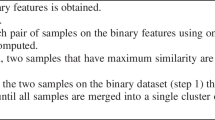Abstract
One of the most important and challenging questions in the area of clustering is how to choose the best-fitting algorithm and parameterization to obtain an optimal clustering for the considered data. The clustering aggregation concept tries to bypass this problem by generating a set of separate, heterogeneous partitionings of the same data set, from which an aggregate clustering is derived. As of now, almost every existing aggregation approach combines given crisp clusterings on the basis of pair-wise similarities. In this paper, we regard an input set of soft clusterings and show that it contains additional information that is efficiently useable for the aggregation. Our approach introduces an expansion of mentioned pair-wise similarities, allowing control and adjustment of the aggregation process and its result. Our experiments show that our flexible approach offers adaptive results, improved identification of structures and high useability.
Preview
Unable to display preview. Download preview PDF.
Similar content being viewed by others
References
Ester, M., Kriegel, H.P., Sander, J., Xu, X.: A density-based algorithm for discovering clusters in large spatial databases with noise. In: Proc. of KDD (1996)
Forgy, E.W.: Cluster analysis of multivariate data: Efficiency versus interpretability of classification. Biometrics 21 (1965)
Jain, A.K., Murty, M.N., Flynn, P.J.: Data clustering: a review. ACM Comput. Surv. 31 (1999)
Zeng, Y., Tang, J., Garcia-Frias, J., Gao, G.R.: An adaptive meta-clustering approach: Combining the information from different clustering results. In: Proc. of CSB (2002)
Gionis, A., Mannila, H., Tsaparas, P.: Clustering aggregation. In: Proc. of ICDE (2005)
Boulis, C., Ostendorf, M.: Combining multiple clustering systems. In: Boulicaut, J.-F., Esposito, F., Giannotti, F., Pedreschi, D. (eds.) PKDD 2004. LNCS (LNAI), vol. 3202, pp. 63–74. Springer, Heidelberg (2004)
Strehl, A., Ghosh, J.: Cluster ensembles — a knowledge reuse framework for combining multiple partitions. Journal of Machine Learning Research 3 (2002)
Filkov, V., Skiena, S.S.: Heterogeneous data integration with the consensus clustering formalism. In: Rahm, E. (ed.) DILS 2004. LNCS (LNBI), vol. 2994, pp. 110–123. Springer, Heidelberg (2004)
Fred, A.L.N., Jain, A.K.: Robust data clustering. In: Proc. of CVPR (2003)
Dimitriadou, E., Weingessel, A., Hornik, K.: Voting-merging: An ensemble method for clustering. In: Dorffner, G., Bischof, H., Hornik, K. (eds.) ICANN 2001. LNCS, vol. 2130, p. 217. Springer, Heidelberg (2001)
Long, B., Zhang, Z.M., Yu, P.S.: Combining multiple clusterings by soft correspondence. In: Proc. of ICDM (2005)
Topchy, A.P., Jain, A.K., Punch, W.F.: Combining multiple weak clusterings. In: Proc. of ICDM (2003)
Bezdek, J.C.: Pattern Recognition with Fuzzy Objective Function Algorithms. Plenum, New York (1981)
Habich, D., Wächter, T., Lehner, W., Pilarsky, C.: Two-phase clustering strategy for gene expression data sets. In: Proc. of SAC (2006)
Author information
Authors and Affiliations
Editor information
Editors and Affiliations
Rights and permissions
Copyright information
© 2009 Springer-Verlag Berlin Heidelberg
About this paper
Cite this paper
Hahmann, M., Volk, P.B., Rosenthal, F., Habich, D., Lehner, W. (2009). How to Control Clustering Results? Flexible Clustering Aggregation. In: Adams, N.M., Robardet, C., Siebes, A., Boulicaut, JF. (eds) Advances in Intelligent Data Analysis VIII. IDA 2009. Lecture Notes in Computer Science, vol 5772. Springer, Berlin, Heidelberg. https://doi.org/10.1007/978-3-642-03915-7_6
Download citation
DOI: https://doi.org/10.1007/978-3-642-03915-7_6
Publisher Name: Springer, Berlin, Heidelberg
Print ISBN: 978-3-642-03914-0
Online ISBN: 978-3-642-03915-7
eBook Packages: Computer ScienceComputer Science (R0)




